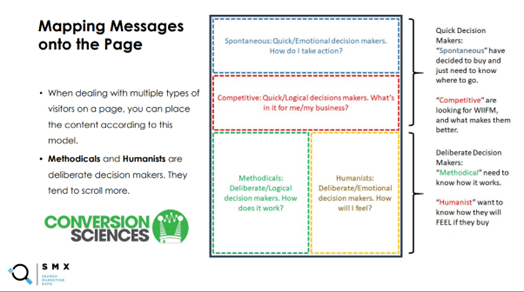Decision-making biases are something we all innately have, which affect our choices many times throughout the day. As a digital marketer for your business, a huge part of your job is understanding others’ biases.
Being able to do so helps you understand their effects on your performance. Today, we’ll discuss decision-making bias specifically in regard to how they impact a landing page.
Types of decision-makers
One way of clarifying people’s tendencies is by breaking them down into different types of decision-makers. We find a basic but useful rundown in four categories: Competitive, spontaneous, methodical, and humanist. The motivations and processes differ for each of these.
Competitive decision-makers want, as the name suggests, the best. This can be something rather superficial or totally the opposite, performance-based. You’ll see messaging towards these sorts of consumers often in sports (“Recharge your electrolytes faster than your enemies with Cougar-Ade. Cougar-Ade: Run faster, grunt louder, and sweat more effusively than your opponents.”), ostensibly high-performance machinery like trucks (“Tow a semi-truck out of the Columbia River with the Fjord F-5000’s one billion horsepower capacity!”), and other items that want to convey maximum performance and superiority.
Spontaneous ones, on the other hand, are more impulsive and more likely to respond to something they believe — either consciously or otherwise — will bring them satisfaction quickly.
Then there are methodical decision makers, which make up a plurality of people — just under half, depending on whom you ask. Obviously, we don’t all make decisions the same way all the time, but more people are more often methodical than anything else. These decision-makers are deliberate and relatively analytical; they identify their “problem,” research which products can help “fix” it, and then will compare their options quite thoroughly before choosing to purchase something.
Lastly are the humanist decision makers. These people especially care about others’ thoughts on products and are particularly concerned with how a product will help their personal growth. They tend to make purchases based on how something makes them feel.
Of course, there’s plenty of overlap in personal decision-making qualities between these four model categories. For example, competitive decision makers will often be powered by their emotional reaction (“The Fjord F-5000 feels like the manliest truck!”) or, alternatively, by a similarly analytical approach (“Cougar-Ade will help me train 10% harder and longer, which will allow me to add 15 miles per hour to my shot, which will increase my goals and help my team win.”) to the methodical decision makers.
Building a landing page for all decision-makers
By seeing this from a behavioral science approach, you can better understand these different decision-makers’ perspectives and subsequently how to convert them.
This all comes down to both the content itself and the messaging through which it’s conveyed.
Further, since you can’t just have a flashing neon sign that says “Methodical decision-makers this way! Spontaneous decision makers over here!” There are still ways to map out a landing page so that it’s as optimal as possible for all decision-making types.
In a nutshell, you can achieve this by placing messaging aimed at spontaneous and/or quick emotional decision-makers up top — these users either already know what they want and just want to get it done with or aren’t going to go down such a deep dive to inform themselves. Either way, you want to appeal to them immediately since their timeline is immediate.
On the opposite end of the spectrum is messaging geared towards the methodical, deliberate decision-makers, which should be more in-depth and can appear further down the landing page, where it can be thorough and more extensive without displacing the rest of the copy. You can also use this part of the landing page to appeal to humanist decision-makers who are also more emotion-based, but still quite deliberate.
In between the “immediate satisfaction” of spontaneous users and the tortoise-speed, inquisitive users, messaging for the competitive decision-maker can fit well. These people tend to think of themselves as logical but aren’t necessarily going to do a deep dive as thoroughly as truly methodical decision-makers. They want to know: What’s in it for me?
Image Source: SMX Advanced
Mitigating decision-making bias through behavioral research
Above, we got into one method to work with users’ decision-making bias instead of against it. Beyond designing your landing page in this way to optimize for the theory behind different users’ behavior, you can go further and adapt your landing page more specifically as you learn more about the specifics of people’s interactions with said landing page.
After creating your landing page and letting it build up a statistically significant amount of interactions, you’ll be able to track certain behavioral data. Some examples that we recommend you keep up with include:
- In-page clicks
- Scroll depth
- User navigation patterns
- Live visitors
- Recordings
- Site speed
These can both directly tell you things you need to know about your landing page’s performance or, depending on what you want to know, can be proxies for other user preferences. What you learn from this data can allow you to make informed tweaks bit by bit to your landing page. The end result will be one that’s even better suited to effectively convey compelling information to not just one, but multiple types of decision-makers.
Also, make sure to take a scientific approach to AB testing your landing page changes; we discussed this testing process in an earlier blog post. Among the most crucial steps is identifying your metrics to measure and — blast back to 7th-grade science class here — control your variables! None of that unscientific willy-nilly messy nonsense!
User behavior can be analyzed to an even greater extent with heat maps and click maps too. With these, you’ll be able to better understand which messaging on your landing page is getting the most attention and through extension pulling the most weight.
Image Source: SMX Advanced
Some best practice tidbits for getting the best performance from your landing page
Just like with all of your advertising and website creation, your landing page should have concise messaging — yes, even when focusing on methodical decision-makers. Just because someone is deliberate and in-depth, doesn’t mean they’ll respond positively to rambling copy. If anything, it’s the opposite. Everyone — regardless of their decision-making tendencies — reacts better to clarity and not having their time and brain power wasted.
Along these lines, clear copy also includes a strong, compelling call to action.
Furthermore, as we alluded to at the beginning of this post, pay attention to the design of your page and which imagery and copy goes where.
What is your number one priority to convey to users? What information or appeal will intrigue users to read further than they were perhaps initially intended? Think about this when deciding what to include above the fold on your landing page. In the same principle, you want to reduce distractions whether that’s imagery, copy, or technical problems like poor loading time or awful pop-up ads.
Take note of other landing pages you come across. Which ones do you have the best experience with as a user? Which one kind of sucks? When you think of this from this perspective, it will help you make better decisions as far as constructing your own.
If you can understand just two qualitative things about landing pages, let it be both the different types of decision-makers and how to create one that gives each of them as positive an experience as possible.
By appreciating the biases people tend towards in making purchasing decisions, you can lay the foundation for how to best communicate with them using the “language” each speaks. This can have a significant impact on users’ experience with your landing page — and through extension with all of your business — and, subsequently, have an equally significant impact on the effectiveness of your advertising.
In the end, don’t cut corners; value understanding the people behind the mouse, and you’ll see that through appreciating their perspective, you’re helping yourself out too.






